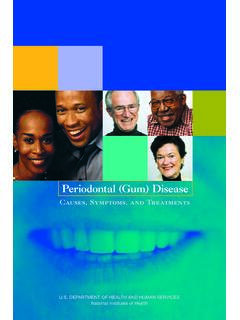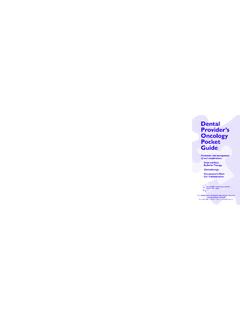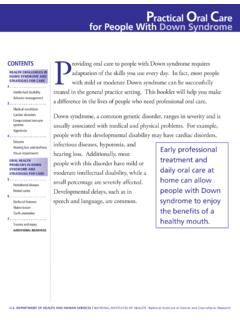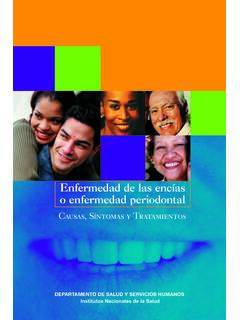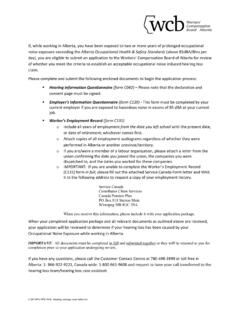Transcription of Practical Oral Care for People With Cerebral Palsy
1 DEPARTMENT OF HEALTH AND HUMAN SERVICES l NatioNal iNstitutes of HealtH l National institute of Dental and Craniofacial Research Practical oral care for People With Cerebral PalsycontentsHealtH C Hallenges In Cerebral Palsy and strategIes for Care2 .. Types of Cerebral palsy3 .. Uncontrolled body movementsPrimitive reflexesMental capabilities4 .. SeizuresVisual impairmentsHearing loss and deafness5 .. DysarthriaGastroesophageal refluxoral HealtH problems In Cerebral Palsy and strategIes for CarePeriodontal disease6 .. Dental cariesMalocclusionDysphagia7.
2 DroolingBruxismHyperactive bite and gag reflexesTrauma and injuryaddItIonal readIngsProviding oral care to People with Cerebral Palsy requires adaptation of the skills you use every day. In fact, most People with mild or moderate forms of Cerebral Palsy can be treated successfully in the general practice setting. This booklet will help you make a difference in the lives of People who need professional oral Palsy is a complex group of motor abnormalities and functional impairments that affect muscle coordination. This developmental disability may be associated with uncontrolled body movements, seizure disorders, balance-related abnormalities, sensory dysfunction, and intellectual disability.
3 For some, the disorder is mild, causing movements to appear merely clumsy or awkward. These patients may need little or no day-to-day supervision. Others, however, experience such severe forms of Cerebral Palsy that they require a wheelchair and a lifetime of personal Palsy itself does not cause any unique oral abnormalities. However, several conditions are more common or more severe in People with Cerebral Palsy than in the general Challenges in Cerebral Palsy and str ategies for CarePeople with Cerebral Palsy may present with physical and mental challenges that have implications for oral care .
4 Before the appointment, obtain and review the patient s medical history. Consultation with physicians, family, and caregivers is essential to assembling an accurate medical history. Also, determine who can legally provide informed consent for different TyPES of Cerebral Palsy are classified according to associated motor impairments:Spastic Palsy presents with stiff or rigid muscles on one side of the body or in all four limbs, sometimes including the mouth, tongue, and pharynx. People with this form of Cerebral Palsy may have legs that turn inward and scissor as they walk, or arms that are flexed and positioned against their bodies.
5 Many also have intellectual disability, seizures, and dysarthria (difficulty speaking).Dyskinetic or athetoid Palsy is characterized by hypotonia and slow, uncontrolled writhing movements. People with this type of Cerebral Palsy experience frequent changes in muscle tone in all areas of their bodies; muscles may be rigid during waking hours and normal during sleep. Dysarthria is also associated with this Palsy is marked by problems with balance and depth perception, as well as an unsteady, wide-based gait. Hypotonia and tremors sometimes occur in People with this rare type of Cerebral Palsy reflects a combination of these who has Cerebral Palsy has problems with movement and posture.
6 Observe each patient, then tailor your care accordingly. Maintain clear paths for movement throughout the treatment setting. Keep instruments and equipment out of the patient s way. Some patients cannot be moved into the dental chair but instead must be treated in their wheelchairs. Some wheelchairs recline or are specially molded to fit People s bodies. Lock the wheels, then slip a sliding board (also called a transfer board) behind the patient s back to support the head and neck. If you need to transfer your patient from a wheelchair to the dental chair, ask about special preferences such as padding, pillows, or other things you can provide to ease the transition.
7 The patient or caregiver can often explain how to make a smooth transfer. (See Wheelchair Transfer: A Health care Provider s Guide, also part of this series.)Positioning for treating a patient in a wheelchair. Note the support a sliding board can provide. Sliding or transfer boards are available from home health care palsyUNCONTROLLED b ODy MOVEMENTS are common in People with Cerebral Palsy . Their limbs move often, so providing oral care can be difficult. When patients with Cerebral Palsy attempt to move in order to help, their muscles often tense, increasing uncontrolled movements.
8 Make the treatment environment calm and supportive. Try to help your patient relax. Relaxation will not stop uncontrolled body movements, but it may reduce their frequency or intensity. Place and maintain your patient in the center of the dental chair. Do not force arms and legs into unnatural positions, but allow the patient to settle into a position that is comfortable and will not interfere with dental treatment. Observe your patient s movements and look for patterns to help you anticipate direction and intensity. Trying to stop these movements may only intensify the involuntary response.
9 Try instead to anticipate the movements, blending your movements with those of your patient or working around them. Softly cradle your patient s head during treatment. Be gentle and slow if you need to turn the patient s head. Exert gentle but firm pressure on your patient s arm or leg if it begins to shake. Try to keep appointments short, take frequent breaks, or consider prescribing muscle relaxants when long procedures are needed. People with Cerebral Palsy may need sedation, general anesthesia, or hospitalization if extensive dental treatment is REFLExES are common in many People with Cerebral Palsy and may complicate oral care .
10 These reflexes often occur when the head is moved or the patient is startled, and efforts to control them may make them more intense. Three types of reflexes are most commonly observed during oral tonic neck reflex: When a patient s head is turned, the arm and leg on that side stiffen and extend. The arm and leg on the opposite side labyrinthine reflex: If the neck is extended while a patient is lying on his or her back, the legs and arms also extend, and the back and neck ref lex: Any surprising stimuli, such as noises, lights, or a sudden movement on your part, can trigger uncontrolled, often forceful movements involving the whole body.
